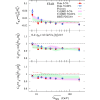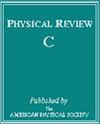New proxies for second-order cumulants of conserved charges in heavy-ion collisions within the EPOS4 framework
IF 3.4
2区 物理与天体物理
Q1 Physics and Astronomy
引用次数: 0
Abstract
Proxies for cumulants of baryon number , electric charge , and strangeness are usually measured in heavy-ion collisions via moments of net-number distribution of given hadronic species. Since these cumulants of conserved charges are expected to be sensitive to the existence of a critical point in the phase diagram of nuclear matter, it is crucial to ensure that the proxies used as substitutes are as close to them as possible. Hence, we use the epos4 framework to generate collisions at several collision energies of the BNL Relativistic Heavy Ion Collider beam energy scan. We compute second-order net cumulants of , , and , for which experimental data have been published as well as the corresponding conserved charge cumulants. We then compare them with proxies, defined in previous lattice QCD and hadron resonance gas model studies, which are shown to reproduce more accurately their associated conserved charge cumulants. We investigate the impact of hadronic rescatterings occurring in the late evolution of the system on these quantities, as well as the amount of signal actually originating from the bulk medium which endures a phase transition.

EPOS4框架内重离子碰撞守恒电荷二阶累积量的新代用指标
重子数 B、电荷 Q 和奇异性 S 的累积量代用值通常是在重离子碰撞中通过给定强子种类的净数分布矩来测量的。由于这些守恒电荷的累积量对核物质相图中临界点的存在非常敏感,因此必须确保用作替代的代用指标尽可能接近它们。因此,我们使用 epos4 框架,在 BNL 相对重离子对撞机束能扫描的几个碰撞能量下生成 Au+Au 对撞。我们计算了已公布实验数据的π、K和p的二阶净累积量以及相应的守恒电荷累积量。然后,我们将它们与先前格子 QCD 和强子共振气体模型研究中定义的代用值进行比较,结果表明这些代用值更精确地再现了它们相关的守恒电荷积。我们研究了系统晚期演化过程中发生的强子再散射对这些量的影响,以及实际来自经历相变的主体介质的信号量。
本文章由计算机程序翻译,如有差异,请以英文原文为准。
求助全文
约1分钟内获得全文
求助全文
来源期刊

Physical Review C
物理-物理:核物理
CiteScore
5.70
自引率
35.50%
发文量
0
审稿时长
1-2 weeks
期刊介绍:
Physical Review C (PRC) is a leading journal in theoretical and experimental nuclear physics, publishing more than two-thirds of the research literature in the field.
PRC covers experimental and theoretical results in all aspects of nuclear physics, including:
Nucleon-nucleon interaction, few-body systems
Nuclear structure
Nuclear reactions
Relativistic nuclear collisions
Hadronic physics and QCD
Electroweak interaction, symmetries
Nuclear astrophysics
 求助内容:
求助内容: 应助结果提醒方式:
应助结果提醒方式:


